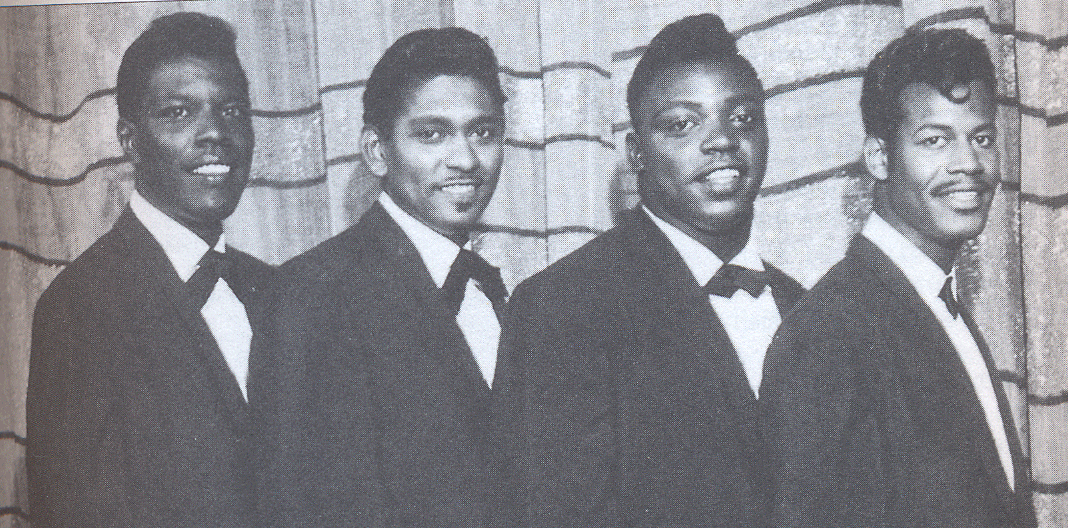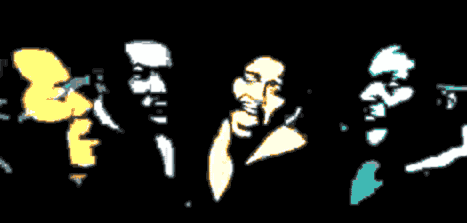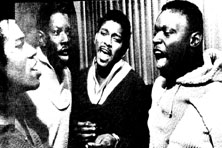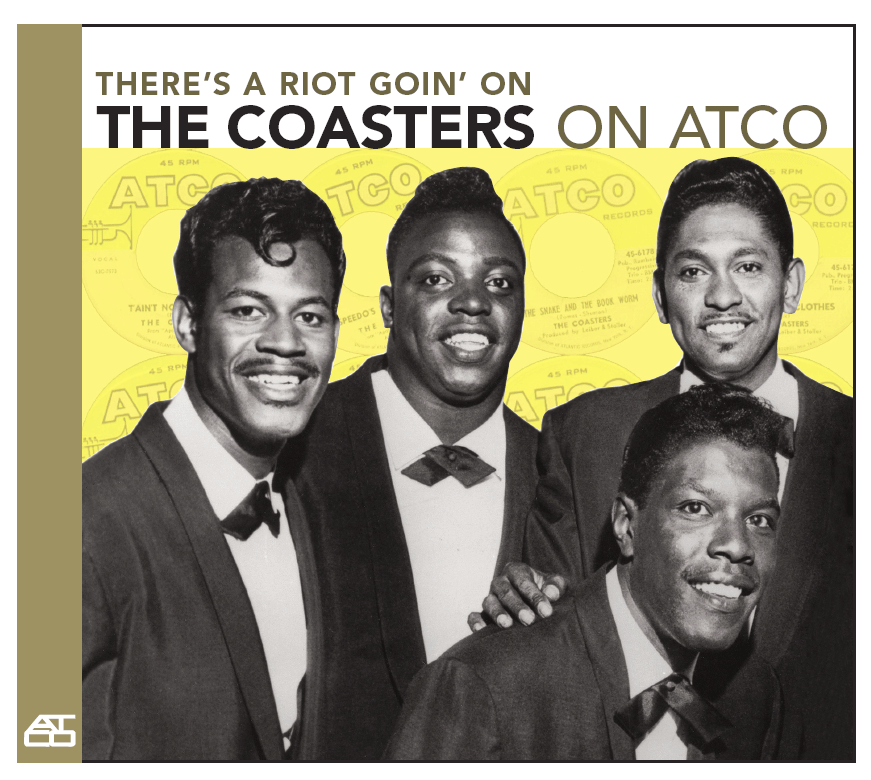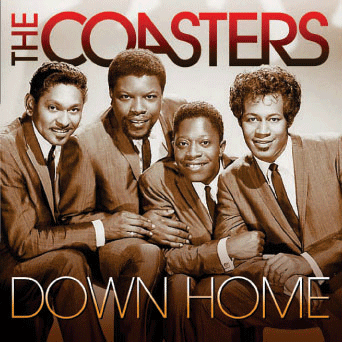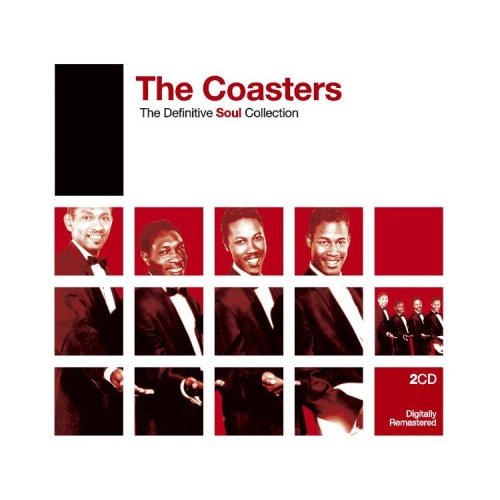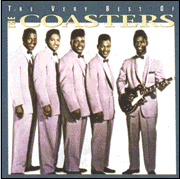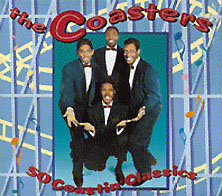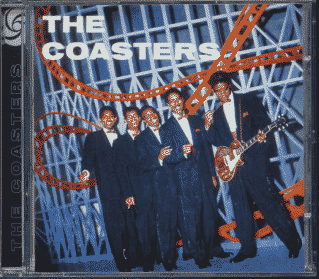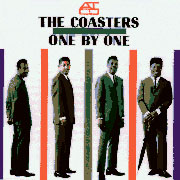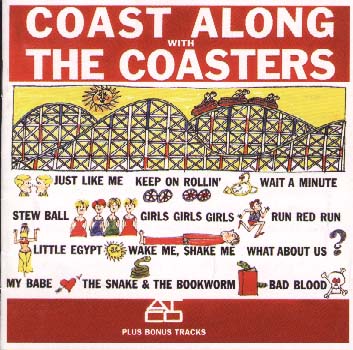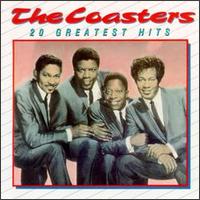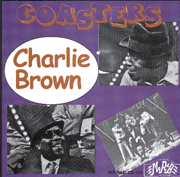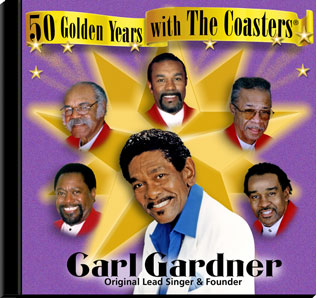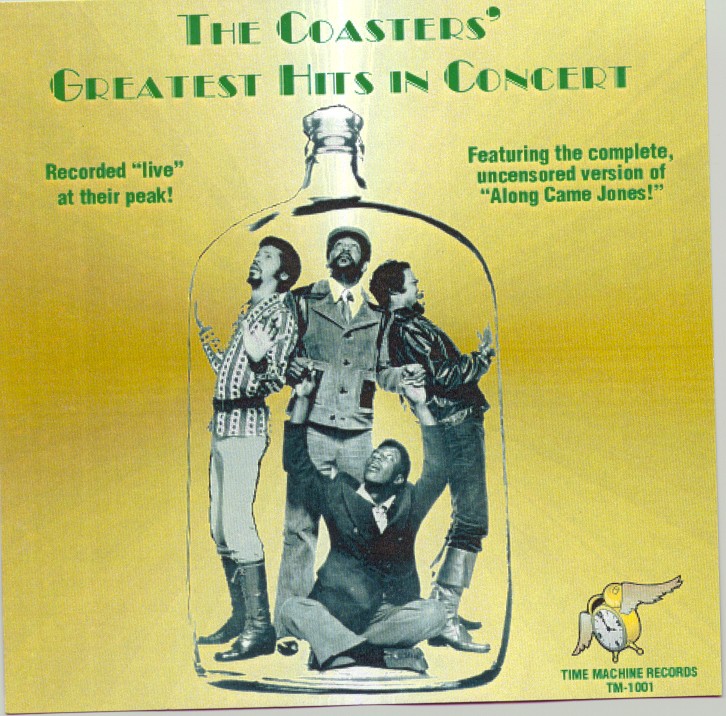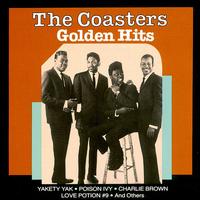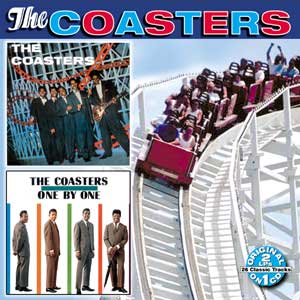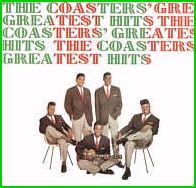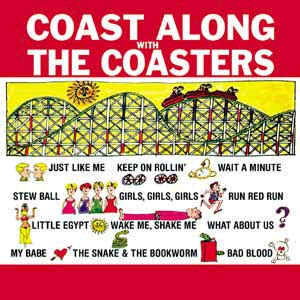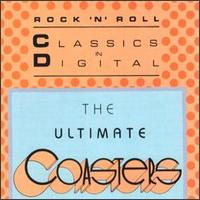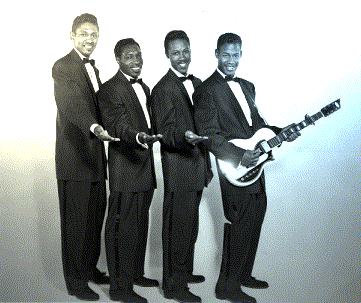From
Robert
Christgau
http://www.robertchristgau.com
Unnaturals: The Coasters With No Strings Attached
Most of
us treasure pop moments--junctures in time when it seemed that every
week brought a new revelation. I was in love for most of 1966, and will
never forget that spell in 1977 when Bleecker Bob was hawking a new
piece of punk every week. But for me, May 1957 was even bigger. In the
wake of the Diamonds' "Little Darlin'" and the Dell Vikings' glorious
"Come Go With Me," and preceding the August onset of Buddy Holly, May
was when we first heard the Everly Brothers' "Bye Bye Love" and Ricky
Nelson's record debut and--at least as striking--Johnny Mathis's "Wonderful
Wonderful." It was also when the Coasters' "Searchin'" blew all of these
away.
Jerry
Leiber was some lyricist, but the impact was sonic: four mixed-down,
oddly harmonized, bass-repressed "Gonna find her"s over Mike Stoller's
alley piano leading to the first classic Billy Guy vocal. For me at 15
and even now, that vocal came from nowhere. I can find rough parallels
in the Clyde McPhatter of "Honey Love" or the Wynonie Harris of "I Like
My Baby's Pudding," in Louis Jordan's ability to sound so delighted with
a lyric that he's gonna bust out laughing any second. But those are
stretches. Fact is, the singer Guy most resembles is either Jerry Leiber
himself--Atlantic sachem Jerry Wexler once claimed that "Billy Guy was a
surrogate for Jerry's interpretations"--or Guy's neighbor and discoverer
Carl Gardner. Guy's big, clear baritone, so wet its growl is a gargle,
shaded at whim into rasp or drawl or slur or even lisp and rose without
warning into the grand slam falsetto of "Bulldog Drummond." Neither
Leiber's intense break on "That Is Rock & Roll" nor his throwaway finale
on 50 Coastin' Classics shows such pipes or timing. But Gardner,
though a tenor, still sings "Searchin'" for a living. He was the
backbone of the Coasters before they knew their name and took as many
leads as Guy in their heyday. It was Gardner, for instance, who lost
sleep over the beribboned sex object of "Searchin'"'s B side, "Young
Blood," which broke top 40 the same week.
That's
right, two Coasters songs at once. May 13, Ricky Sings Fats; May 20,
Coastermania. Young rock and rollers didn't then know "Down in Mexico"
or "Turtle Dovin'," or Leiber and Stoller's productions with the Robins,
as the West Coasters were called before half of them migrated from L.A.
to New York and Atco Records: for comic social criticism, "Framed," sung
by bass man Bobby Nunn; for comic social unrest, "There's a Riot Goin'
On," sung by very special guest bass man and future "Louie Louie"
composer Richard Berry; and for the premise of a Broadway revue,
Gardner's "Smokey Joe's Cafe." So the thrill of their greatest record
was pretty hot, and "Young Blood" made it hotter. Bill Millar--whose
1975 biography, along with Claus Rohnisch's well-tended website, is the
main source of Coasters facts--has gone so far as to brand it pedophilic:
a song about "middle-aged blacks who relished the idea of importuning
adolescent girls in the street." A survey of contemporaries of both
sexes has failed to locate who anyone who recalls taking it that way;
two male hipsters who played in racially integrated bands assumed
twentysomethings hitting on a teen queen, but most heard kids coming on
to other kids, and several shared my misapprehension that the Coasters
themselves were the young bloods.
Who knew
how old they were? Even those lucky enough to catch their live show
couldn't tell that Gardner and replacement bass man Dub Jones were both
29 while Guy was 21 and Cornel Gunter only 19. What we did know was
that--on the major hits, "Searchin'" "Young Blood," "Yakety Yak,"
"Charlie Brown," "Along Came Jones," and "Poison Ivy"--they were
representing not "middle-aged blacks" but teenagers, and not black
teenagers but teenagers who happened to be black. What seemed old about
them was the popular culture references "Searchin'" supposedly
introduced to rock and roll discourse. With the saving exception of
Dragnet's Sergeant Friday, the detectives Guy invoked--Sam Spade,
Charlie Chan, Boston Blackie, Bulldog Drummond himself--were staples of
Jerry Leiber's '40s youth known to the teen audience from old movies on
television or radio shows remembered barely if at all. Like Eddie Cantor
and Ed Wynn on The Colgate Comedy Hour, "Searchin'" taught high
school students that pop culture had a history as surely as Shakespeare
and Silas Marner.
But this
was also an early instance of vernacular intellectuals' urge to certify
as popular their own formative influences--always already a little dated,
like the "cherry red '53" of Chuck Berry's 1964 "You Never Can Tell," or
the alt-country on NPR. In the Coasters' "The Shadow Knows," the radio
sleuth of the title solves cases television heroes Marshall Dillon and
Wyatt Earp can't. One wonders as well how current the black-cultural
references Leiber fed the Coasters were--references submerged in the
hits but integral to low-life succes d'estimes from "Smokey Joe's Cafe"
to "Idol With the Golden Head" to "D.W. Washburn," not to mention the
1960 tour de force "Shoppin' for Clothes." As May '57 became history,
pop music's chroniclers worried about this. In 1970 Charlie Gillett
argued that the "indolent and stupid" stereotype implied by Dub Jones's
"deep, 'fool' voice" was a tradition of black-on-black comedy, but by
1972 he'd reconsidered: "The trouble with most of Leiber and Stoller's
songs is that they describe improbable or incongruous situations and get
too many of their laughs from making black clowns out of the singers."
Millar lets Johnny Otis, who still thinks he's owed royalties on "Hound
Dog," complain at length that Leiber and Stoller "dwelled entirely on a
sort of street society." And in 1989, Coasters fan Dave Marsh
regretfully concluded that the Coasters' "subtleties and universality"
had been "overwhelmed" by "a climate in which covert race-baiting runs
the country, from the streets of New York and Los Angeles to our
political campaigns."
I had
thought scrutinizing such claims might tease out the Coasters'
affinities with minstrelsy, but the claims didn't survive much scrutiny.
The Game, Condoleezza Rice--these are black people whose role-playing
white people have a right to find morally noxious. Not the Coasters, who
as per Gillett extend a black comedic tradition--which as Gillett
doesn't mention traces back to minstrelsy because show business does.
And now Gillett has re-reconsidered: "I was writing before Richard Pryor
and Eddie Murphy, before hip-hoppers turned everything on its head in
terms of presenting black life in songs, and before Quentin Tarantino
start[ed] writing 'nigger' into his scripts for both white and black
characters to say." Marsh specifically denies that the Coasters invited
racist interpretation in the '50s. And two crucial African-American
critics are fans: Mel Watkins, whose history of African American comedy
singles out "Shoppin' for Clothes," which "received scant notice outside
the black community," and Nelson George, who gives credit for the
Coasters' "deft vignettes" to "two young Jewish men [who] grew up around
blacks"--which they did, Leiber as a ghetto grocer's son, Stoller in the
kind of family that sent their kids to interracial camps, both as blues
and jazz fans who joined black and Pachuco social clubs, respectively,
in their teens. So maybe it's time to reclaim the subtleties and
universality of an artistic entity specializing in what Leiber once
called "the joke that the poor tell on themselves," an entity Greil
Marcus reduced to eight words in 1979: "Stepin Fetchit as advance man
for black revolt." The Coasters don't get enough respect.
Unlike
Chuck Berry, Little Richard, Buddy Holly, and the Everlys, the Coasters
were not Rock and Roll Hall of Fame charter members--they had to wait a
year for the 1987 batch, which also included Ricky Nelson, Clyde
McPhatter, Louis Jordan, and Leiber and Stoller. Nor has their star
risen since--not compared to such fellow '87s as B.B. King, Bo Diddley,
Aretha Franklin, and Marvin Gaye. It doesn't help that they were
comedians--funny never gets respect, because it doesn't give it. And
their body of major work isn't large, although neither is Little
Richard's or Buddy Holly's, or in any obvious way seminal. The deep
reason racial anxieties cut into their status is that they don't seem
like primal creators. They permit no fantasy of the natural. The problem
is less content than structure--the calculation of the whole project.
The Coasters are seen as producers' puppets, like the Monkees or 'N
Sync--famously, not only did Leiber plot out every line, Stoller wrote
King Curtis's sax breaks. That the concept had white men pulling black
men's strings is merely an additional drawback.
As
someone who retches quietly at the idea that Stax-Volt was a lost
biracial utopia, I refuse to get teary-eyed about Leiber and Stoller.
They were so gifted that their signature product proved
inimitable--unlike "Love Me" or "I (Who Have Nothing)" or their other
stroke of genius, the violins they added to the Drifters' "There Goes My
Baby," which someone else would have thought of (the Robins tried to get
them out of RCA in 1953) but which as a matter of actual historical
development was a decisive mutation in the evolution of r&b. But they
were also, Leiber especially, incorrigible wise-asses and aspiring
aesthetes, hipsters who quit r&b in the late '60s and produced little of
interest thereafter. Nevertheless, to disrespect the Coasters is to set
exceedingly high standards of racially integrated art. As Nelson George
avers and even Johnny Otis allows, Leiber and Stoller wrote their songs
from within a black culture they knew intimately and observed
acutely--not all of black culture, as if anyone could do that, but the
part of it that generated the music they loved most. Inflected by
Leiber's incipient pretensions, incongruous associations, and love of
radio, that intimacy underpinned even the teenified "Yakety Yak" and
"Charlie Brown." And it was turned into music by four strong black men.
Eight Coasters all told recorded between 1956 and 1968. But there were
just four hitmaking Coasters from 1957 (actually 1958; ed.note) to 1961: Carl Gardner, Billy Guy,
Cornel Gunter, and Dub Jones.
Only
Gardner is still alive, and only Gardner has left a substantial
record--an unpublished autobiography (it was published in June, 2007;
ed.note). But the others are clear enough in
outline. Bass man Jones was shy and religious yet made for comedy. He
first displayed his depth with the Cadets, who anticipated the Coasters'
shtick with the 1956 novelty "Stranded in the Jungle," a James
Johnson-Ernestine Smith composition recommended to students of racial
stereotyping. Jones quit in 1967 after he contracted fear of flying and
was replaced by the title character in Johnny Cymbal's "Mr. Bass Man,"
Ronnie Bright. Texan-born Guy teamed with a Chicano partner in a
successful L.A. comic duo called Bip and Bop when he was just 18, and
was enlisted by Gardner, who knew him from the block. Endowed with
timing and imagination as well as that baritone, he often devised his
own deliveries, adapting or overruling Leiber. By the time he got
spooked by the same airplane incident as Jones, he'd made several solo
stabs, and for a while he reportedly earned a living doing blue material
in Vegas lounges. Cornel Gunter was an out gay who was built like a
prize fighter and served as the Coasters' muscle when things got rough
on the road. As the group's best-trained singer, he often corrected the
others when they forgot their harmonies, and eventually wrote some
voicings himself--on "Shoppin' for Clothes," for instance. He left to
back Dinah Washington in 1961 and after she fired him formed the first
fake Coasters (Nunn started his Coasters, Mark II around that time too;
ed.note). Gunter was a notorious liar. No one knows why he was shot
to death in Las Vegas in 1990.
As with
most musicians, the bulk of the Coasters' niggardly income came in on
the road, where their comic polish was hell to follow. Leiber and
Stoller never witnessed a Coasters show until well into the '60s and
contributed nothing to their routines, which Guy and Gunter usually
invented. Not very puppetlike. This wasn't a George Martin-Beatles or
Quincy Jones-Michael Jackson situation where the operator with the
educated line of patter gets credit for the genius of his social
inferiors. Leiber and Stoller were the creators here. The group was
their concept, the members their material; Stoller's piano was the
lynchpin of the Coasters' superb interracial bands. But even in the
studio Guy and Gunter were collaborators, not stooges. And Guy and
Gunter weren't the guys with the big ideas--Carl Gardner was.
If Leiber
and Stoller imposed their ideas on anyone, it was Gardner, who will
nevertheless celebrate 50 years as a Coaster in November. From a family
of self-described "house niggers" in Tyler, Texas--one sister sang opera
in New York for a while--Gardner says he learned early on how to get
ahead by catering to white people. A born-again Christian now, he once
followed Malcolm X into Islam, and he's a bitter critic of white racism.
Gardner moved to L.A. at 25 to become a big-band singer. But, he
reports, when Robins-Coasters manager Lester Sill told him, "'Either you
sing these particular tunes, Carl, or we just have to forget it,' I
says, 'O.K. money's first' so I took this group thing." Gardner made
side money, though less than the other Robins, as a pimp--one white
girl, one black. He's angry to this day that Leiber and Stoller broke
their promise to bill the post-Robins "Carl Gardner and the Coasters,"
not least because it might have simplified all those
trademark-infringement suits in the '80s and '90s. Live he was Zeppo,
the straight man and romantic lead, and although he dismisses the notion
that the Coasters' songs "depicted blacks as ignorant and
superstitious," he never gave up his pop dreams. In 1960, with the
Coasters' six top 10 hits behind them, he got Leiber and Stoller to let
them do a standards album. One by One was cut in two days to
specially prepared orchestral tapes. As Gardner brags, his rapt,
pellucid attack does "Satin Doll" proud, though I doubt Atlantic buried
it so he wouldn't make like Ben E. King and go solo. But to my ear,
Gunter is the star of the set, lisp and all.
Gardner's
is the familiar saga of a star impoverished by changing fashion, greedy
management, and callous royalty disbursement. He obsesses on the parade
of fake Coasters--Gunter had some, Guy had some, Nunn had some, an
ex-Robin who was never in the Coasters had some, their relatives had
some--and overestimates the moneys due him more wildly than WEA
underestimates them. But late in life he married a woman who rebuilt his
career, and he is one of the rare oldies acts who doesn't cater to white
people by performing other artists' hits--his DVD offers no "Blue Moon"
or "Get a Job," just a "Stormy Monday." If in his perfect world he would
have been a big-band singer, he settled for organ-and-horns r&b when he
recorded his first solo album at 68, and at 68 his tenor was too shot to
handle "I'll Be Seeing You" or "Don't Let the Sun Catch Crying," as the
bonus borrowings from One by One make clarion clear.
In all
this, Gardner shares much with Leiber and Stoller. Some of the Coasters'
greatest records were created after "Poison Ivy" became their last top
10 in 1959. Neither "Run Red Run," a minor hit about a monkey who learns
to play poker and steals his teacher's car, nor its r&b-charting B side
"What About Us," a joke that the poor tell on the rich, quite earns
Greil Marcus's "Stepin Fetchit drops his mask, and pulls a gun," but
they were pretty redolent. Stoller judges the tent-show fantasy "Little
Egypt" "the epitome of the comic playlets." "Bad Detective," "Soul Pad,"
"Down Home Girl," and "D.W. Washburn" weren't altogether au courant, but
aged well. And anyone troubled by the unprimality of Leiber and
Stoller's control-freak side--one reason "Searchin'" has such life may
be that, according to Leiber, it was recorded in nine minutes with the
board gone haywire like some Chess mess--should compare "Shoppin' for
Clothes" to the looser Kent Harris record it appropriated, because its
precision tells. Curtis Mayfield listened and learned; the Beatles'
rendition of "Searchin'" was why George Martin signed them. Yet as the
hits dried up, Leiber and Stoller--who back in 1958 had told Time
magazine: "Kids nine to fourteen make up our market, we're tired of
writing rock 'n' roll, but we can't stop"--decided to stop. Carl Gardner
had his pop dreams, and they had their art dreams. There was Peggy Lee's
"Is That All There Is?" Then there was that Joan Morris and William
Bolcom album--"Either a different, more conservative kind of art," John
Rockwell observed in 1978, or "inflated and pretentious overreaching on
the part of songwriters who should have stuck with simpler forms."
Fact is,
both Leiber and Stoller and Carl Gardner were best when, as Leiber
described his ideal pianist in "That Is Rock & Roll," they played
between the cracks. Is the monkey in "Run Red Run" Nat Turner or John
Muhammed--or J. Fred Muggs? Is the protagonist of the Coasters' crudest
hit sneaking a cigarette or setting a trash-can fire? "Charlie Brown"'s
crap game is a cheap move, a big fat slice of watermelon foisted on Dub
Jones's Charlie--who, whatever his vocal presence, is no more black than
Dub Jones's Salty Sam, the six-reeler villain bedeviled by a
white-on-white cliche who shares Dub's surname in "Along Came Jones." At
worst, Charlie is a trouble-making goof-off who happens to be black, a
small-time teen hero whose "Why's everybody always pickin' on me" is as
universal as his slow walk, although one originated in white culture and
the other in black. Once he's out there, of course, he's ripe for
reinterpretation. In my life, "Charlie Brown" provided the beat to which
a Vermont tent-show queen--white, weary, with a scar on her tummy and no
rubies in sight--gave me my first disquieting glimpse of vulva.
There
really is a street society, and whatever its limitations, in the '50s it
was a crucial corrective to postwar fantasies of domesticity. Its
African-American variant lured Carl Gardner as well as Jerry Leiber. It
is to the credit of all those who created the Coasters, black and white,
that their version of that society deployed racial stereotypes with the
purpose of muddling them, turning them into jokes that have no
end--because that's so much more bearable than a tragedy that has no
end.
Experience Music Project, Seattle Washington, April 16, 2005
Carl Gardner (vocals; April 29,
1928), Cornell Gunter (vocals; born November 14, 1938, died
February 27, 1990), Billy Guy (vocals; born June 20, 1936, died
November 5, 2002), Will “Dub” Jones (vocals; born May 14, 1928,
died January 16, 2000)
From 1956 to 1961, the Coasters
released a string of classic singles that reflected the life of
the American teenager with keen wit and hot, rocking harmonies.
Invariably those songs were written, produced and arranged by
the duo of
Jerry Leiber and Mike Stoller. The union of a black vocal
group with two Jewish songwriters was one of the most propitious
in rock history. Leiber and Stoller’s witty, street-smart
“playlets” were sung with sly, clowning humor by the Coasters
and accompanied by the hot, honking “yakety sax” of
King Curtis. The Coasters’ parlayed their R&B roots into
rock and roll hits by delivering Leiber and Stoller’s
serio-comic tunes in an uptempo doo-wop style. Beneath the humor
the songs often made incisive points about American culture for those willing to dig a little deeper.
Leiber has described the Coasters’
style as “a white kid’s view of a black person’s conception of
white society.” In fact, their success showed how thin was the
line between rhythm & blues and rock and roll in the Fifties.
“Our songs…were R&B hits that white kids were attracted to,”
Leiber said in a 1992 interview. “And if people bought it, it
became rock and roll.”
The Coasters placed fourteen
songs on the R&B charts, eight of which crossed over to the pop
Top Forty. From 1957 to 1959 the Coasters unleashed a half dozen
singles that dominated the charts in one of the most formidable
runs of the rock and roll era: “Searchin’ (#1 R&B, #3 pop),
“Young Blood” (#2 R&B, #8 pop) (actually #1 R&B;
ed.note), “Yakety Yak”
(#1 R&B, #1 pop), “Charlie Brown” (#2 R&B, #2 pop), “Along Came
Jones” (#14 R&B, #9 pop) and “Poison Ivy” (#1 R&B, #1 pop)
(actually #7 pop; ednote).
Leiber and Stoller remarked that the Coasters “were fun to work
with, they were fun to be with. They were a great bunch of
clowns and they made our songs sing.” It was such a potent
combination of writing and performing talent that beyond the
Coasters’ well-known hits lies a wealth of lesser known but
equally fascinating treasures, such as “That Is Rock and Roll,”
“Shopping for Clothes,” “Run Red Run,” “What About Us” and “Idol
with the Golden Head.” (with a further two pop Top Forty
hits; ednote).
The roots of the Coasters date
back to 1949 with the formation of the Robins, a black vocal
group, in Los Angeles. In their early years they were affiliated
with producer
Johnny Otis and recorded for Savoy Records. In 1951 they cut
a song by Leiber and Stoller entitled “That’s What the Good Book
Says.” In 1954 the Robins signed to Leiber and Stoller’s label,
Spark Records, where they cut some notable R&B sides. These
include such early examples of the duo’s narrative style as
“Riot in Cell Block #9,” “Framed” and “Smokey Joe’s Cafe.” In
1955 Atlantic Records offered Leiber and Stoller an independent
production deal with their Atco subsidiary, which meant a move
from the West Coast to the East Coast. The Robins came to Atco
as part of the package, but the move divided the group. Bass
singer Bobby Nunn and tenor Carl Gardner headed to New York
City (actually first after Gunter's and Jones' entrances in late
1957; ednote), were they recruited tenor Leon Hughes and baritone Billy
Guy and rechristened themselves the Coasters - a sly reference
to their coast-to-coast relocation. The group’s classic lineup
solidified with the addition of tenor Cornell Gunter and bass
Will “Dub” Jones (a former member of the Cadets and the Jacks),
who replaced Hughes and Nunn, respectively.
In 1957, the Coasters topped the
R&B charts and made the pop Top Ten with their double-sided
single “Searchin’” and “Young Blood.” Over the next two years,
the Coasters released a series of hit singles filled with
instantly adaptable slang and timeless humor. “Yakety Yak”
comically addressed the generation gap long before that term was
coined, while “Charlie Brown” was a character study of a class
clown that featured Will “Dub” Jones’ unforgettable line: “Why’s
everybody always pickin’ on me?” By the end of the decade,
they’d carved out a legacy for themselves as purveyors of
riotously funny rock and roll records with a solid R&B
underpinning.
The Coasters were also popular in
England, where
the Beatles,
the Rolling Stones and other British Invasion bands covered
their songs. Ironically, it was the rise of the British Invasion
that spelled commercial decline for such Fifties icons as the
Coasters. Leiber and Stoller left Atlantic in 1964 to found
their own label, Red Bird, while the Coasters continued to
record for Atco through 1966. The two parties reunited in 1967
when the Coasters signed with Columbia Records’ Date subsidiary.
The Coasters and Leiber and Stoller last worked together in
1973 (actually 1971; ednote). Over the ensuing decades, various Coasters lineups
continued to work the oldies circuit.
|


